 By Pepper Parr
By Pepper Parr
March xx, 2015
BURLINGTON, ON
Part 2 of a 2 part feature
When David Donnelly gets wound up he is close to a force of nature. His explanations and solutions for saving the environment are those of a driven man.
His mission is to offset the influence, clout and financial muscle of the development community – his current focus is the threat to Ontario’s greenbelt
He is one of those lawyers in the province who does his environmental homework home work and asks the hard but to him very obvious questions.
He formed his law practice in 2008, the year the bottom fell out of the financial world.
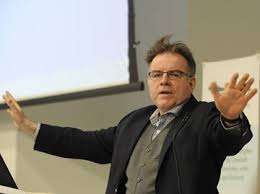
David Donnelly: a force to be reckoned with once he gets wound up.
He keeps a close eye on the development community and brings 25 years of experience and expertise to his work. During the early March Town Hall meeting held recently in Burlington to rally the troops for the forthcoming public meetings on the Land Use Planning Consultations the province is holding starting late in March.
There will be a meeting in Hamilton on April 22 and another in Milton on April 16th.
There are people with wheelbarrows full of money and the patience of Job who have cast their covetous eye on all that lands in Burlington north of Dundas. They are whispering in the ears of the politicians and the bureaucrats on the e need to open up some of that land to residential development so that municipalities in Halton Region can meet their growth targets.
Donnelly points out that:
The population of Greater Toronto and Hamilton (GTAH) area Golden Horseshoe is expected to be 3.7 million by 2031.
The GTAH, which includes the Region of Halton is expected to accommodate 2.3 million people by 2031
The city of Toronto is to add 470,000 people by 2031
Donnelly math works like this:
With 2.3 million more people projected for the GTAH (which includes Hamilton) everything outside Toronto is going to have to absorb 1.83 million people. That figure is the e 2.3 million provincial projection less the 470,000 Toronto will absorb = 1.83 million
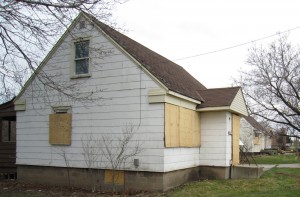
Burlington allowed six original Veterans Land Act properties to be assembled into a project that has 54 units. City council spent more time squabbling about keeping a tree than they did about how cramped this community is now.
Where will this growth go: Donnelly projects 60% of it will be greenfield and 40% intensification.
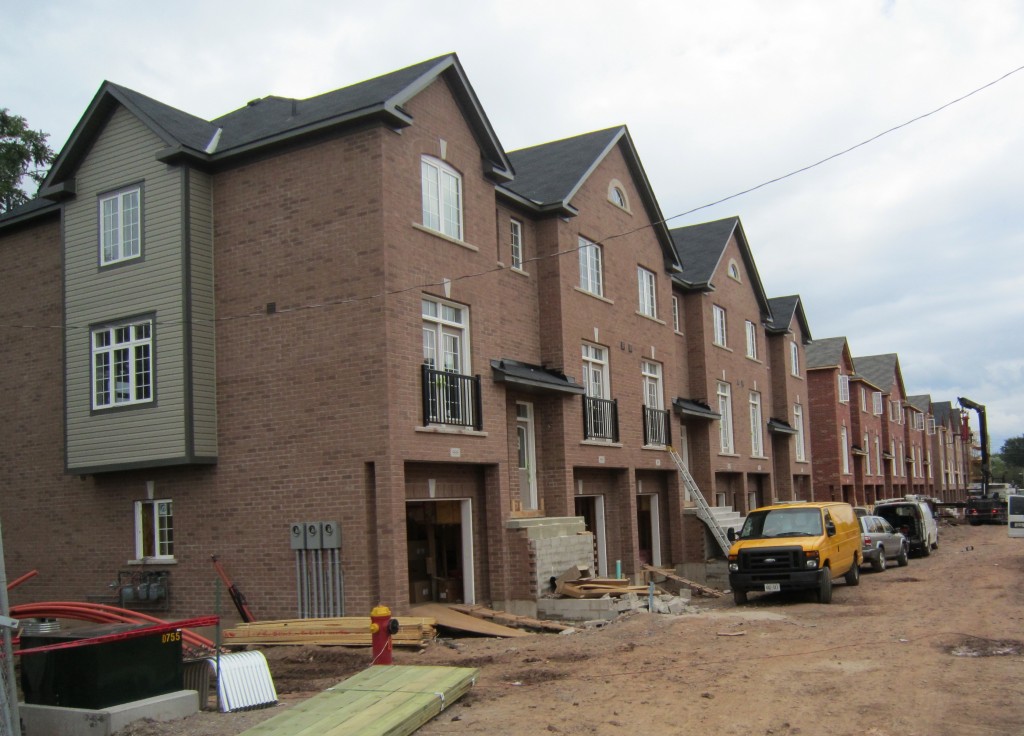
This 58 unit project replaced six small bungalows – seen to the left. Intensification – just not good community.
Burlington politicians continually talk about being built out but there are two large sites that are primed for development: Eagle Heights in the west end of Aldershot and the Bronte Meadows property along Upper Middle Road and Burloak. The Meadows is currently designated Employment Lands but there are a number of reasons to believe that it will be changed to residential.
Burlington also has a number of mobility hubs that are more of an idea than a reality at this point but offer significant intensification opportunities for the city.
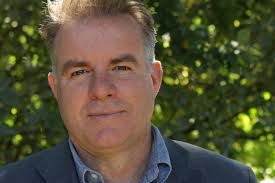
David Donnelly: leading environmental lawyer spoke recently in Burlington
Donnelly explains that from 2006-2011, the overall intensification rate (excluding Toronto)
was 39%. Greenfields accommodated 61% of that growth.
Donnelley’s Greenfield math produces the following:
1.83 million X 0.60 = 1.1 million people on Greenfield sites
He projects 2.99 residents/unit
More Donnelly math:
1.1 million people ÷ 3 residents/unit = 367,000 Greenfield units required (single/semi/townhouse)
That’s how many people the area will have to accommodate – 367,000
Where will the houses they live in be built? Some Greenfield, some by intensification claims Donnelly.
What Donnelly is pointing out is that the land in the rural part of Halton – and large part of the greenbelt, which the developers want to move into is not necessary
Donnelly argues that the land supply is not an issue
He explains:
Greenfield supply in GTAH is already designated at 47,000 hectares
Take that 47,000 ha X 17 units/ha = 800,000 units
800,000 units X 3 people/unit = 2.4 million people
No need to encroach on the greenbelt argues Donnelly – the existing land will accommodate all we are expected to have to accommodate into 2031 – Donnelly didn’t project beyond 2031.
He adds an additional twist to his argument that there is no reason to touch the greenbelt.
The 2006 Census reports 370,000 units occupied by 65+ year old residents
In 2031 there will be 370,000 units (singles/semis/towns) occupied by 90+ year old residents
Back to that Donnelly math:
370,000 units X 3 residents/unit = 1.1 million people
We need Greenfield land for 1.83M people by 2031, or 600,000 units
We have land designated to accommodate 2.4M people, or 800,000 units
Coming back into the market, are 370,000 already-built singles/semis/towns to accommodate 1.1M people
We have ground-related units to accommodate 3.5M people or roughly double the 1.83M to be accommodated.
Ipso facto – we don’t need to touch as much as a square foot of greenbelt land for housing.
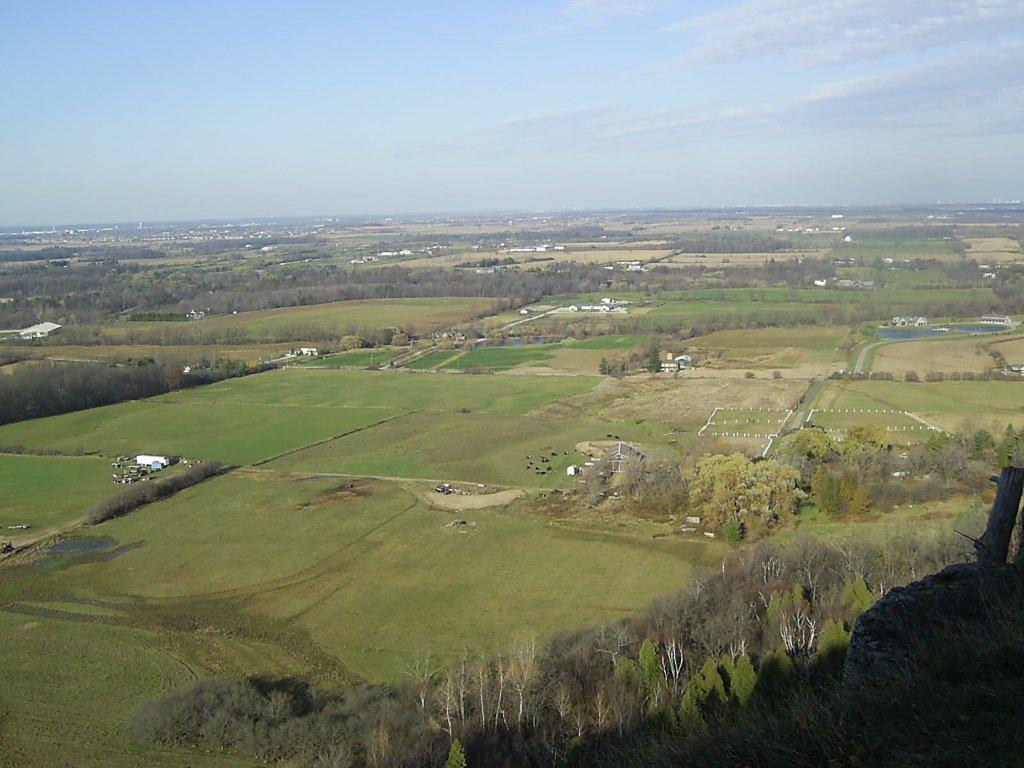
Paert of the Ontario Greenbelt that makes up North Burlington – which some argue is under threat and has to be protected from unnecessary development. Province has scheduled a series of Land Use development meetings across the province.
This isn’t an argument that is going to sit all that well with the development community which has very deep pockets and great lobbying bench strength – plus significant clout as a result of the election campaign contributions.
But it is the argument David Donnelly and the Rural Burlington Greenbelt Coalition will be taking forward during the public hearings.
One those occasions when Donnelly gets to orate on the defense of the environment – he can get really wound up. Facts, especially figures, literally gush out of him. When he is done his body slumps a little and a “there – do you get it?” look spreads across his face.
David Donnelly has done his thing – and if you believe his numbers – he has done it well. He will be doing this frequently in the months ahead.















I’m not sure how the density math is relevant. Could we house 5 million people inside the greenbelt in a way that improves the living conditions for all? Yes. Are we doing that? No. You can’t just rubber stamp every development application in the intensification zone, exclude all development from the green belt and get anything, but a horrific mess.
The perfect Orwellian term for “overcrowding” is, intensification.